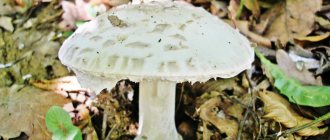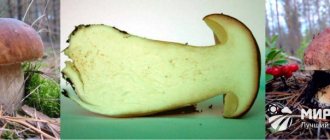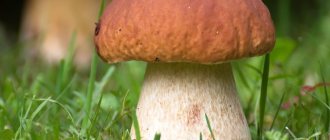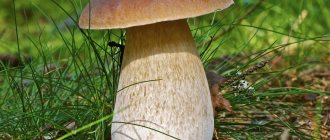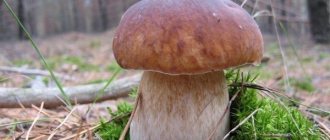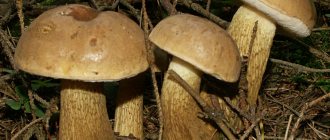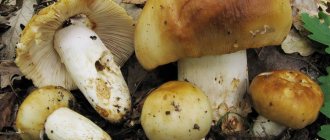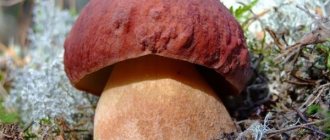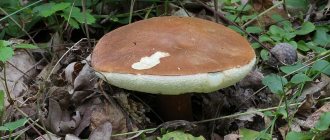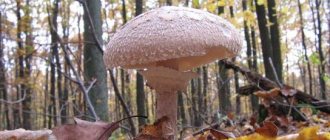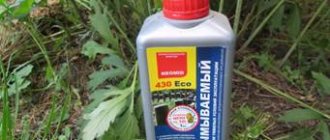Silent hunting is quite an exciting activity, and the white mountain mushroom is considered the favorite trophy of all mushroom pickers. It is not only tasty in any form, but also contains a lot of useful substances.
Description
The white mountain mushroom has several names: Giant Svinukha, Giant Govorukha, Huge Leusopaxillus, White Crimean Mushroom. These species grow in groups: if you encounter one fungus, then most likely there are several more nearby.
The following signs are characteristic of a talker:
- a fleshy and rather large cap, which can grow up to 20 centimeters in diameter;
- the surface of the cap is smooth, under it there are plates with jumpers;
- the leg is dense and short relative to the cap, its length can vary from three to eight centimeters, thickened below, covered with pile on top;
- the color is predominantly white, but there are individuals of a coffee-milk shade;
- has a pleasant mealy aroma.
Important: the white mountain mushroom is easily confused with the smoky talker, which is similar in appearance and taste. However, you should be careful not to come across poisonous gall mushrooms in a clearing with whites.
Characteristic features of the Crimean porcini mushroom
All mushrooms have their own morphological and species characteristics, and this variety is no exception. The giant talker belongs to the Oryadovaceae family and the Belosvinukha genus.
Appearance and photo
Before you go hunting for mountain mushroom, you need to know exactly what it looks like. It is not difficult to determine. In order not to confuse white pig with an inedible variety, just study its description and look at the photo.
The giant talker is a fairly large white specimen. However, as the white pig grows, the cap may acquire a pleasant light coffee shade.
The appearance changes slightly as it matures. As the fruiting body grows, both the color and shape of the cap changes. In immature specimens, the cap has a flat-convex shape, which, as it matures, takes on the shape of a deep funnel. The surface of the cap can sometimes crack into scales. As a rule, this only happens with very old talkers.
White pig has a pleasant, mild mushroom aroma and dense or creamy flesh that does not change color when cut.
Structure and species differences
The giant white pig is widely popular among Crimean mushroom pickers.
- Dense and fleshy, quite large in size. Its diameter ranges from 8 to 30 cm.
- Color – from white to light coffee (cream).
- As it grows, the cap changes its shape. If at first it is flat-convex, then over time it acquires a funnel-shaped shape with a deep depression in the center. There are jumpers on the back of the cap.
- The texture is dense.
- The size of the leg is not significant when compared with the size of the cap, since its length is 4-7 cm and thickness is 2.5-3.5 cm.
- A powdery coating may appear on a light, almost white or white stem.
- The shape is club-shaped or barrel-shaped, thickening towards the bottom.
- White or cream color.
- It has a mild powdery odor.
The govorushka must be carefully cut with a sharp knife, almost at soil level. You cannot pull out or twist the fruiting body, as such actions will damage the mycelium.
Basic recommendations
A lot of mushrooms grow on the Crimean peninsula, and not all of them can be eaten, so before you go on a “quiet” hunt, you need to familiarize yourself with simple recommendations that will help avoid adverse consequences.
Firstly, you need to know what this type of white pig looks and smells like, and secondly, get acquainted with the place where it grows.
This type spoils especially quickly, so it is recommended to collect it in a wicker basket, where the product will not get crushed and will not overheat, as in a plastic bag or bucket. It is better to place the “harvest” in a container with the caps down, so the chances of damage to the fruiting body will be reduced to zero.
To extend the life of an already cut “harvest,” it is better to go hunting early in the morning, since white pigs rot and deteriorate faster when exposed to sunlight.
Difference from false, inedible mushrooms
As a rule, it is difficult to confuse the giant white pig with other species, since no other specimen has both a white color and such an impressive hat size.
Mountain mushroom not only has a good taste, but also does not have false inedible doubles as such. Only mushrooms from the genus Govorushka can be remotely similar to it, but the size, shape and color of the cap do not allow them to be confused with each other.
Poisonous
On the Crimean Peninsula they also encounter poisonous specimens. You should go on a “quiet hunt” only if you know how to distinguish edible mushrooms from inedible representatives.
fly agaric
Description. The red fly agaric is a poisonous mushroom whose appearance is recognizable to everyone. The cap is located on a high stem, up to 2.5 cm thick. As it matures, the cap rises to a height of up to 20 cm. By this time, from the shape of a hemisphere, it takes on an umbrella appearance, reaching up to 20 cm in diameter. There are characteristic white inclusions on the surface of the red cap.
Varieties. Deadly poisonous mushrooms include the white spring fly agaric, which is considered the closest relative of the toadstool - it is similar in appearance to it. It is distinguished by a white cap when fully expanded, acquiring a flat shape at maturity, 10 cm in diameter. At the initial stage of growth, the cap of the mushroom is spherical. Leg height – up to 12 cm.
Who can be confused with? It is impossible to confuse the red fly agaric with any mushroom.
Where does it grow and when? The red fly agaric is found in mixed forests with a predominance of conifers, on acidic soils. Begins to bear fruit from August to October.
Satanic mushroom
Description. Satanic mushroom is a poisonous specimen with predominantly white or slightly yellowish flesh. When broken, the flesh becomes bluish or reddish. The fruiting bodies have a slightly spicy odor when young; mature mushrooms smell like rotten onions. They have a spherical or barrel-shaped leg, red-yellow at the top, reddish-orange at the bottom, and reddish in the middle.
Who can be confused with? The satanic mushroom is similar to other boletus mushrooms, especially the first-class porcini mushroom.
Where does it grow and when? The mushroom grows in deciduous forests with calcareous soils next to chestnut, oak, hornbeam, and beech. The fruiting bodies ripen from June to September.
Cherry-brown silverfish
Description. The inedible mushroom Lepiota squamata (red-brown silverfish) in its youth is dominated by a convex cap, which over time becomes plano-convex, reaching 2-5 cm in diameter. The cap is whitish, covered with brownish-reddish scales. The leg is cylindrical, 4-8 cm in height. The surface is smooth, yellowish or slightly pinkish.
Who can be confused with? The cherry-brown silverfish can be confused with an edible specimen, Lepiota corypus.
Where does it grow and when? The mushroom bears fruit from June to September-October. Found in coniferous, mixed and deciduous forests, pastures, meadows, and vegetable gardens. It has an unpleasant rare smell and a disgusting taste.
False foam
Description. There are several varieties of false mushrooms. They are all similar in appearance. These are small lamellar mushrooms with a cap diameter of no more than 7 cm and a stem length of less than 10 cm.
Varieties. The following types of false mushrooms are found on the territory of Crimea:
- Sulfur yellow. Poisonous mushrooms, growing in groups, have fused bases of the legs. The young mushroom has a bell-shaped cap, which becomes flat over time, but retains the characteristic tubercle in the center. The diameter of the cap is no more than 5 cm, sulfur-yellow or bright yellow-brown in color. It is distinguished by a cylindrical stem, often curved and the same color as the cap.
- Brick red. A bell-shaped red-orange cap, with a smooth surface and yellowish plates that turn black as they ripen. The leg is thin, hollow inside and usually slightly curved.
Who can be confused with? The mushroom is confused with the edible honey mushroom.
Where does it grow and when? False mushrooms are found in forests where the fungi infect spruce, aspen and birch, settling in large groups on stumps. Fruiting continues from the beginning of summer until the end of October.
Death cap
Description. A deadly poisonous mushroom with a grayish or greenish cap, up to 15 cm in diameter. The shape resembles a hemisphere, then opens up and becomes flat. The mushroom has white flesh with a weak odor and taste.
Who can be confused with? Due to inexperience, toadstool can be confused with champignons or russula.
Where does it grow and when? The pale grebe prefers to grow on fertile soils, light mixed oak and beech forests. Fruits in early summer. Occurs singly or in groups.
False fox
Description. False chanterelle is a poisonous mushroom with a golden or yellowish convex, sometimes funnel-shaped cap, 2-5 cm in diameter. The center of the cap is darker than the edges. It is dominated by a thin stalk of a reddish color with a characteristic orange tint.
Who can be confused with? False chanterelles are often confused with edible mushrooms. But the main difference between these species is the edges of the cap: in the false mushroom they have an uneven shape, in the edible chanterelles they are wavy.
Where does it grow and when? False chanterelle grows in mixed forests. The fruiting bodies ripen in August and last until the end of autumn.
Lepiota brown-red
Description. A poisonous mushroom with a cap of the fruiting body, thin-fleshy in consistency, covered with dark scales on top and plates on the reverse side. At the beginning of ripening, the cap is bell-shaped, then becomes flat with a characteristic dark tubercle in the center. The diameter of the cap is up to 7 cm. The thin, sometimes curved stem of the mushroom is white on top and dark red below.
Who can be confused with? Outwardly, it somewhat resembles a pink wave.
Where does it grow and when? Fruits in mid-June until the end of summer. It is found in individual specimens or groups in forest plantations, squares, gardens, and parks.
Patouillard fiber
Description. Patouillard fiber is a deadly poisonous mushroom with a bell-shaped cap at the beginning and then spread out, with a characteristic tubercle in the center. It cracks in old age. Young mushrooms have a whitish cap, which later becomes reddish, straw-yellow. The leg is dense, slightly swollen at the base. Length – up to 7 cm. Color is the same as the hat.
Who can be confused with? The poisonous mushroom is confused with some varieties of champignons and entolomas.
Where does it grow and when? Putayara fiber grows from May to October in coniferous and deciduous forests. It appears abundantly in August and September in places where caps, champignons and other edible mushrooms grow.
Poisonous talkers
Description. Talker mushrooms can be of different colors. The young mushroom has a hemispherical cap, which then becomes depressed. The fleshy and large cap reaches a diameter of at least 10 cm. In normal weather, the surface of the mushroom is smooth and dry. The club-shaped leg reaches up to 8 cm in height.
Varieties. There are the following types of poisonous talkers:
- Pale. The cap of the mushroom is off-white or grayish, sometimes with brown or gray spots. The young talker is distinguished by a convex cap with smooth, turned-up edges. In adulthood, the cap becomes horizontally flat. The curved cylindrical leg reaches up to 5 cm in height.
- Reddish. It is distinguished first by a convex cap with rolled edges, then by a flat shape with a depression in the center. The surface of the cap of a young mushroom is white, covered with frost. Often strange reddish spots are visible on the cap. The cylindrical stem reaches a height of up to 4 cm. The mushroom has a powdery odor or smells like a recently cut tree.
- Waxy. A mushroom with a convex, then flat, slightly later concave, funnel-shaped cap, 3-8 cm in diameter. The edges of the cap are curled and turned up. The color is whitish, with a gray-cream tint, and dark edges. Sometimes there are dirty pink spots on the surface. The color of the leg varies from whitish to dirty ocher. The shape is cylindrical, often curved. Smells of wood and flowers.
Poisonous pale talker
Poisonous reddish talker
Poisonous waxy talker
Who can be confused with? The red talker can be confused with the edible meadow mushroom.
Where does it grow and when? Poisonous talkers grow in coniferous and deciduous forests, most often under oaks, spruce, pine and beech trees. The fruiting season begins in summer and ends at the end of autumn.
Tiger row
Description. Tiger row has a spherical cap, 4-10 cm in diameter. Gradually the cap becomes more convex, then completely spread out with thin edges turned down. There are specimens with caps ranging from off-white to silver-bluish. On the surface of the cap there are small scales spreading out in flakes in a circle. The height of the cylindrical leg reaches up to 12 cm, 2-4 cm in diameter.
Who can be confused with? Has no edible counterparts.
Where does it grow and when? Tiger rowers grow in small colonies, like a “witch’s ring.” Rarely found alone. The fruiting bodies form a symbiosis with coniferous trees and are occasionally found in mixed and deciduous forests. They prefer to create mycorrhizae with pines, beeches, lindens, spruces, and oaks. They bear fruit from August to late October-early November.
Champignon dark scale
Description. The dark scaly champignon is characterized by a convex, pale brown cap with dark scales, 6-10 cm in diameter. It grows on a long, smooth white stem. The plates of the mushroom are frequent, pale, grayish-pink, becoming brown in maturity. It has white flesh that does not change color when cut, except that it turns slightly yellow at the base of the stem.
Who can be confused with? The mushroom is confused with the edible forest champignon with reddened flesh.
Where does it grow and when? The poisonous mushroom is found extremely rarely in the autumn. It is found on the soil in deciduous forests, on compost heaps, and rotting straw.
Useful properties and limitations
White pig has not only nutritional value, but also pharmacological activity. The fact is that the giant talker synthesizes an antibiotic - clitocybin A and B, the action of which is directed against the tuberculosis bacillus. Talkers also contain a large number of microelements necessary for the human body, including zinc, copper, manganese and B vitamins.
In addition, they stimulate the removal of waste, toxins and other harmful substances from the body and are used in dietary nutrition. This type of white pig is used in the production of some medications, such as Nebularin, Clitocybin and others.
How to get there
Airplane
There is only one airport in Crimea, located in Simferopol. Bus number 49 runs to the city center. There is a bus station on the territory of the airport where they sell tickets to all cities of Crimea. There is a taxi and car rental service.
Official site:
new.sipaero.ru
Car
You can get to the peninsula through the Crimean Bridge, which connects the Krasnodar Territory and Kerch.
From Moscow:
along the M4 Don highway, then exit onto the A290 Novorossiysk - Kerch highway.
From Saint-Petersburg:
along the M10 highway with a transition to the M4 Don, then exit onto the A290 highway.
From Krasnodar:
along the A146 highway, then exit onto the A290 highway.
Check out the most interesting routes for motorists.
Answers to common questions
The white Crimean mushroom is a rather exotic species found in the Crimea. Despite the fact that the species belongs to the conditionally edible mushrooms, it is still widely popular among mushroom pickers, who quite often go to the mountains or villages just for it.
“At the same time, if all the preparatory steps are followed (thorough cleaning, washing and quick cooking), certainly edible mushrooms should not be pre-cooked before sauteing under any circumstances. This rule applies to porcini mushrooms, chanterelles, saffron milk caps, champignons, morels, umbrella mushrooms, cap mushrooms, russula and row mushrooms. Of course, prolonged heat treatment of mushrooms will not harm the human body. However, the nutritional value of “our forest beef” decreases, its taste deteriorates and its aroma weakens. In addition, some of the edible mushrooms become slimy after boiling.
«>
There is also no need to cook greenhouse champignons, oyster mushrooms and all fresh-frozen mushrooms that can be bought in stores before frying. Moreover: champignons grown on a sterile substrate can even be eaten raw, for example, added to a salad.”
Consider these my cockroaches. I think. that mushrooms need to be boiled. All. I feel calmer this way. But this does not affect the taste of mushrooms. I just ate a portion of fried whites. Boiled it before frying. Very tasty. Everyone always cooked mushrooms for me - my grandmothers, my father, my friends. And that’s what I do and will continue to do. And there’s nothing better than cheese to finish a glass of wine and nothing better than wine to finish a slice of cheese (c)
I believe that mushrooms must undergo long-term heat treatment. These are my cockroaches. This doesn’t affect the taste in any way, but for me it’s even tastier if it’s boiled with spices before it’s hot. And there’s nothing better than cheese to finish off a glass of wine and nothing better than wine to finish off a slice of cheese (c)
Clearly, I thought maybe there’s a scientific basis and I’m doing it wrong. And we’re straight out of the woods and into the frying pan. The eyes are afraid - the hands are doing it.
I tried mushrooms that were not cooked. They seemed harder and more rubbery to me. I prefer boiled ones. And I feel calmer this way. I don’t pretend that I’m doing the right thing. But in my family it’s customary And there’s nothing better than cheese to finish a glass of wine and nothing better than wine to finish a slice of cheese (c)
This is how it is in my family. In principle, I do not consider mushrooms to be a safe food. Therefore, I personally feel more comfortable eating myself and feeding my family with mushrooms that have undergone longer heat treatment. What does this have to do with your soup? And there is nothing better than cheese to finish a glass of wine and nothing better than wine to finish a slice of cheese (c)
Mushrooms are cooked, in my opinion, for certain purposes. In some mushrooms the bitterness is removed by cooking, in other mushrooms the dark broth is drained, and in each case this is done for a specific purpose. Why do you eat that? I don’t understand what you’re afraid of. In any case, the porcini mushroom, together with saffron milk cap, belongs to the highest category of mushrooms and does not require additional cooking. (And saffron milk caps can generally be eaten raw, I didn’t like it). Next, I will point out your inconsistency: you advised the author to cook the soup, but you did not advise draining the first broth , when frying, you pre-cook the mushrooms, although it is enough to boil them in their own juice in a frying pan for 10-20 minutes (depending on the type of mushrooms, the size of the cut and the quantity in the frying pan). Washed mushrooms always give juice in the pan, but draining or boiling it is a matter of taste. Longer heat treatment will not save you from mushroom poisoning; it makes the mushrooms less aromatic and healthy. And about the soup - I was bragging, kind of on topic.
Try it sometime! No, really. Get over your prejudices and fry yourself boletus. How delicious it is! They are. sweet. Now I fry moss mushrooms and white ones just like that. I also boiled it before.
Common boletus
Common boletus
They are distributed everywhere, but there are especially many of them in the Belogorodsky region of Crimea, in the village of Zelenogorskoye, as well as in Strogonovka and on the Ai-Petri plateau. Growing season: June – end of October. They love bright meadows and forest edges. Found in meadows. Insects like to eat boletus, so in the summer mushrooms are often simply eaten away by them. But by autumn the situation will normalize.
It is very difficult to confuse boletus with other mushrooms. Their name speaks for itself. The fleshy, juicy caps seem to be smeared with oil: they are slippery and slimy, brown or light brown in color. In mature butterflies, the caps open, taking on the shape of hemispheres. The older the mushroom, the higher the edges. The skin is easy to separate from the pulp. Under the cap there is a tubular layer with small yellow pores.
The legs are lighter than the cap, thin, up to 10 cm long. A white ring is clearly visible on a mature mushroom.
Butternuts cannot be stored for a long time, so after harvesting they must be cooked quickly. Before cooking (frying, boiling, canning), you need to remove the thick skin and sort them. All wormy mushrooms are thrown away. Then they are soaked for an hour in water with salt and completely cleaned of dirt.
Before marinating, they are boiled for 15-20 minutes. During cooking, you can add a little onion to the water, this will add piquancy to the future dish. Next, they need to be tipped into a colander and dried a little. Pickled in any way.
The boletus is frozen, boiled in water (cooking time - 5 minutes), dried and placed in small portions in plastic bags. After defrosting, butter mushrooms are stored for only a short time, so you only need to take out the required amount of mushrooms from the freezer.
Where and when to look
The Crimean climate is very diverse and unpredictable, so the beginning of the mushroom season differs in different parts of the peninsula. While in one part of Crimea there are no traces of mushrooms yet, in another part of Crimea the season is in full swing.
It was also noticed that fruiting bodies grow there not only in forests, but also in clearings and roadsides. However, the talker, beloved by many mushroom pickers, still prefers traditional places - coniferous and deciduous forests. It is there, under the trees, that they grow. These mushrooms can be collected from early summer until mid-autumn.
Distribution area in Crimea
The ideal habitat for the giant pig is deciduous forests and dense forests located in the mountains and at their foot. Mushrooms can be found in the eastern part of Crimea, steppes and mountain ails.
Group growth made these mushrooms noticeable, and if at least one specimen is found, then this is a guarantee that somewhere nearby you can find a whole family, forming the so-called witch’s ring. However, a few representatives of the family can grow not only in the mountains, but also in forest belts located in flat areas, and even in open areas.
Something to remember!
If you find mushrooms along busy roads, you should not collect them, as they tend to absorb harmful substances. Experts strongly do not recommend eating such fruits due to the risk of developing general intoxication of the body.
Dangerous twins
Before you go on a quiet hunt, it is recommended that you carefully study the materials about poisonous mushrooms. Accidentally collecting these is very dangerous for human health and life. The gall fungus is considered to be the poisonous counterpart of the giant pig.
Its appearance differs from its white relative in the following ways:
- the pattern on the leg of a poisonous individual is dark, while that of an edible one is white;
- it has a swollen fibrous base, and its shape resembles a club;
- the lower part of the cap of the inedible mushroom is pink;
- in wet weather, the surface of the cap becomes covered with a sticky layer;
- if the mushroom is broken, its flesh will quickly turn red;
- It has been noted that it does not attract worms, has a mild aroma and a bitter taste.
In order to cause irreparable harm to health, it is enough to simply try inedible mushrooms.
Autumn honey mushrooms
Autumn honey mushrooms in Crimea
Real autumn honey mushrooms are collected everywhere from the end of August to the end of autumn. These mushrooms almost never grow alone. They usually parasitize whole families on trees and stumps. Prefer moist soil.
In young honey mushrooms, the cap is concave inward, with growth it opens and becomes flat (size from 2 to 15 cm). The legs are long - up to 10 cm. The color of the caps and legs is the same - honey, but they have flake-like scales of a dark color, which is why honey mushrooms look brownish and slightly fluffy. There is a filmy ring under the cap.
False poisonous honey mushrooms have a gray-yellow color. The cap is whitish at the edges and has no scales. The pulp is light yellow with a bitter taste and earthy smell. The spore powder is brown, while in the autumn honey mushroom it is white.
Honey mushrooms can be prepared in different ways. It is better to boil peeled honey mushrooms in salted water for about five minutes. Be sure to then place them in a colander and allow the water to drain. Before serving, they are crushed, poured with sour cream or sprinkled with green onions. For pickling, cook for 20 minutes, after rinsing and removing dirt. After cooking, place in a glass container, add bay leaf, pepper, onion and dill. It is good to place mushrooms and additives in layers, one on top of the other.
Preparation
Dishes with mushrooms are appropriate for both everyday and festive tables. White mountain has excellent taste and quite impressive size. The taste and aroma of these mushrooms allows them to be used as a main or additional ingredient in a variety of cooking options. However, you should remember about mandatory heat treatment.
Cleaning
As you know, mushrooms are a fairly perishable product; they cannot last long. Cleaning is the first stage of preparation for further processing. First, the mushrooms should be thoroughly washed and dried. While the product is drying, you can prepare your cleaning tools.
- Bowl;
- sharp knife;
- a small brush (an unnecessary toothbrush will do);
- towel.
Milk mushrooms
Pepper milk mushroom
Mushroom pickers come across mushroom pickers in mixed forests in the summer. Rarely found in the foothills and mountainous regions of Crimea. The main harvest season is July and September. Active growth begins after heavy rains.
There are no real milk mushrooms in Crimea, but oak, pepper and dry milk mushrooms grow. Pepper milkweed can be distinguished by its funnel-shaped white cap with grayish spots. On its narrow plates drops of milky juice are noticeable, which tastes very bitter. The leg is short, narrowed below. You can eat the mushroom after repeated soaking.
The dry milk mushroom also has a white cap, but with brown spots. The plates have a bluish color. The bitter juice does not appear after breaking. The mushroom is ideal for pickling and pickling (after pre-soaking).
In the mountainous part of Crimea you can find oak milk mushrooms. These reddish lamellar mushrooms grow in deciduous forests. Brown stripes are easily visible on their caps. Legs with yellow pits lose their density as they grow. Suitable for marinating, frying, boiling.
Chanterelles
Another name is cockerels. The lands of the Simferopol region are rich in them. There are many of them near the village of Mramornoe. Mushroom pickers also go to the forests of Belogorsk, Kirov, and Bakhchisarai regions.
Chanterelles grow in numerous groups in sunny places, in clearings or next to clearings. They are also found in moss, among birches, pines, and spruces. Appear from the beginning of June. You can collect all summer until the first autumn frosts.
A distinctive feature of the structure: the mushroom does not have a pronounced transition from the stem to the cap. Uniform color: yellow (shades vary from light to dark, almost orange).
The hat has an irregular shape with wavy, unfolded edges that form a depression in the center. But its surface is absolutely smooth. The leg tapers downwards, the length is about 5 cm. The flesh is fleshy, dense, with a slightly sour taste. When pressed, it acquires a reddish tint. The smell is weak.
It must be distinguished from the false chanterelle, whose cap has no bends and resembles small funnels. In addition, their color is always orange, closer to red. The yellow hedgehog also looks like a chanterelle. This is an edible yellow mushroom. It has a fleshier cap and a thicker white stalk.
Chanterelles are very good for health. They help get rid of helminths, have a beneficial effect on liver cells (containing ergosterol in mushrooms), and are a source of vitamins. Increases the body's resistance to infections.
Chanterelles are easy to transport; they do not break when carried. You can cook it in any form. True, when fried they somewhat lose their taste. Pairs well with other mushrooms, such as porcini and boletus.
Mice (gray row)
There are several types of rows that can be eaten. But they are quite difficult to distinguish from inedible ones. More often, mice are found in coniferous and mixed forests, in moss or on sandy soil. Rows can grow singly or in groups.
In Crimea they are found in early or mid-autumn. Experienced mushroom pickers go specifically for them to the forests near the village of Kolchugino or to the area of the Crimean Astrophysical Laboratory.
The hats of young mice (5-10 cm) have a conical shape with rolled edges. In mature rows it is flat, fleshy, with irregularities. The edges are unraveled and have small cracks. A small bump protrudes in the center. The plates in it are rare and widely spaced. The color of the cap is gray (from light to dark shade). After rain, it looks slimy and becomes slightly sticky, which causes leaves and small lumps of earth to stick to it, making it difficult to notice.
For steppe oyster mushrooms in Grushevka
Grushevka is located near Sudak. It only takes about 40 minutes to get there. In addition to mushroom places, there are also the remains of two settlements from the Bronze Age and the Middle Ages.
The second name for steppe oyster mushroom is single-barrel. Local residents also give her other funny nicknames: ungulate, duck. An interesting mushroom that grows uniquely - on grass. The harvest can be from late spring to November in spiny tartar or field eryngium.
Are there other places where you can pick mushrooms in Crimea? Certainly. In the village of Nauchny around the observatory there are many suitable areas. Porcini mushrooms are hidden on the South Coast, milk mushrooms - in the Bakhchisarai region, oak mushrooms - in the mountains.
Saffron milk caps
Saffron milk caps
Appear in forests from July. They love shade and cool places under trees. They grow in large groups. In Crimea, their recognized place is Rybachye; they are also often found in the forests of the southern coast of Crimea.
The orange caps grow up to 12 cm in diameter. The bottom has reddish plates that turn green when pressed. the skin on them is a little sticky. The hollow legs, up to 2 cm thick, have dimples. The flesh of saffron milk caps is dense, sweet and has a fruity aroma.
Ryzhiki can be prepared in any way. They are salted very quickly: within two hours you get delicious salted mushrooms. The main thing is to add more spices.
Shot glass mushrooms. What mushrooms can you eat without harm to your health? List of edible mushrooms
Knowledge about edible mushrooms will be useful to every mushroom picker. Edible mushrooms include those mushrooms that are safe to eat and do not require special preparation. Edible mushrooms are divided into several types, the most famous of them: tubular, lamellar and marsupial. You can read more about edible mushrooms in this article.
Signs
Edible mushrooms are mushrooms that do not require special processing and can be cooked and eaten immediately. Edible mushrooms do not contain any toxic substances that can harm the body; they are absolutely safe for humans.
The nutritional value of edible mushrooms falls into four categories, from high-grade to low-grade mushrooms.
In order to distinguish edible mushrooms from inedible ones, you need to know some common distinguishing features:
- edible mushrooms do not have a specific pungent odor;
- the color of edible mushrooms is less bright and catchy;
- edible mushrooms usually do not change color after the cap is cut or broken;
- the flesh may darken when cooked or broken;
- In edible mushrooms, the plates are attached to the stem more firmly than in inedible ones.
All these signs are conditional and do not provide an exact guarantee that the mushroom is edible.
On video
clearly shows how to distinguish edible mushrooms from poisonous ones using the example of the most common mushrooms. It also tells you what to do in case of poisoning:
Conditionally edible
In addition to edible ones, there are also conditionally edible mushrooms. They are classified in a separate category because they produce a bitter juice or contain poison in very small quantities.
Such mushrooms must be subjected to special processing before cooking, namely:
- soak (from 4 to 7 days);
- boil (15-30 minutes);
- scald with boiling water;
- dry;
- salt (50-70 g of salt per 1 liter of water).
Among conditionally edible mushrooms, even with special processing, it is recommended to consume only young specimens, without signs of aging or rotting.
Some mushrooms may only be inedible if eaten with other foods. For example, dung beetle is not compatible with alcohol.
There are 3 types, which are divided into edible and conditionally edible.
Tubular
Tubular mushrooms are distinguished by the structure of their cap, which has a porous structure resembling a sponge. The inner part is permeated with a large number of small tubes intertwined with each other. Mushrooms of this type can usually be found in the shade of trees, where there is little sunlight, damp and cool.
Among tubular mushrooms, both edible and conditionally edible ones are common. Their fruits are very fleshy and have high nutritional value.
Among the edible tubular mushrooms there are many poisonous look-alikes. For example, a safe porcini mushroom can be confused with an inedible gall mushroom. Before picking, you should carefully study the characteristics of edible fruits.
Advice from experienced mushroom pickers
The first rule of a mushroom picker says that you can only put in a basket those fruits whose edibility does not raise the slightest doubt. It is better to prefer proven mushroom places to spontaneously chosen areas. You can definitely bring a full basket from there.
Advice! It is better to go to the forest early in the morning. The glare of dew will help you find mycelium faster. You should definitely take a sharp knife and a basket with you, or, in extreme cases, a box, since fruits in bags can break.
Some mushroom pickers stubbornly break the fruits out of the mushroom area, despite strong recommendations to use a knife. In this case, the damaged myceliums stop bearing fruit and die.
The Crimean lands abound in a variety of mushrooms. Among them there are both edible and poisonous species. Therefore, it is better to go on your first mushroom picking trips with experienced specialists.
Raincoats
Raincoat
Puffballs are mushrooms that cannot be poisoned. But when collecting them, you still need to check their flesh: in a real raincoat it is always white. Giant and pear-shaped raincoats are common in Crimea. The first has a fruit body that is round and white, but becomes yellowish over time. Can reach a height of 34 cm.
Also interesting to read: Poisonous mushrooms of Crimea
The fruiting body of the pear-shaped puffball is very similar in shape to a pear. The skin is rough with small tubercles. Raincoats grow in the foothills, choosing rotten wood for themselves.
Only young mushrooms are suitable for food. They are dried or fried. They also make a delicious mushroom soup. In terms of nutritional content they can be compared with white ones.
